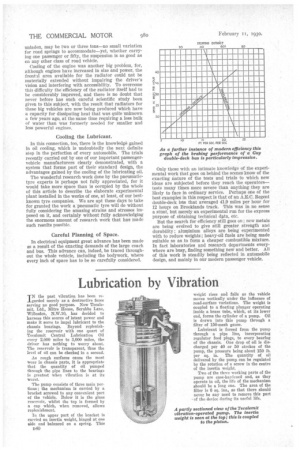Lubrication by Vibration
Page 134

If you've noticed an error in this article please click here to report it so we can fix it.
IN the past vibration has been regarded merely as a destructive force serving no good purpose. Now Tecalemit, Ltd., Mitre House' Scrubbs Lane, Willesden, N.W.10, has decided to harness this source of latent power and make it serve to impel lubricant to the chassis bearings. Beyond replenishing the reservoir with one quart of Tecalemit Central Lubrication Oil every 2,000 miles to 3,000 miles, the driver has nothing to worry about. The reservoir is transparent, thus the level of oil can be checked in a second.
As rough surfaces cause the most wear in chassis parts, it is appropriate that the quantity of oil pumped through the pipe lines to the bearings is greatest when vibration is at its Worst.
The pump consists of three main portions; the mechanism is carried by a bracket screwed to any convenient part of the vehicle. Below it is the glass reservoir, whilst the lop is formed by a cap which, when removed, allows replenishment.
In the upper part of the bracket is carried an inertia weight, hinged at one side and balanced on a spring. This D40 weight rises and falls as the vehicle moves vertically under the influence of road-surface variations. The weight is coupled to a floating plunger operating inside a brass tube, which, at its lower end, forms the cylinder of a pump. Oil is drawn into this pump through a filter of 150-mesh gauze.
Lubricant is forced from the pump through a pipe line, incorporating regulator feed plugs, to every bearing of the chassis. One drop of oil is discharged per 40 or 50 strokes of the pump, the pressure being about 150 lb. per sq. in. The quantity of oil delivered by the pump can be regulated by the rotation of a screw in the centre of the inertia weight.
Two of the three working parts of the pump are case-hardened and, as they operate in oil, the life of the mechanism should be a long one. The area of the filter is 6 sq. ins., so that there should never be any need to remove this part of the device during its useful life.




























































































































































































































